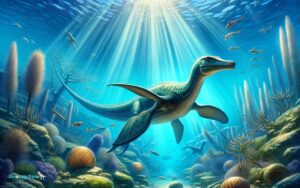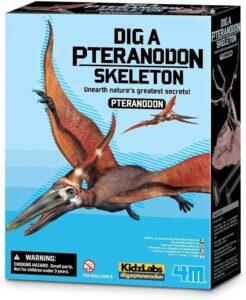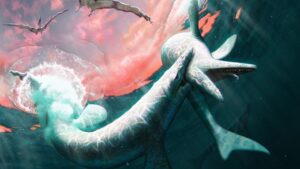What Dinosaur Looks Like a Crocodile
In the vast tapestry of prehistoric life, certain creatures enjoyed a design that was ahead of its time, bearing striking resemblances to modern-day animals. Among these ancient marvels, one dinosaur stands out for its crocodilian features, igniting curiosity among scientists and enthusiasts alike.
This reptile, with its elongated snout and powerful tail, blurs the lines between land-dwelling dinosaurs and their aquatic reptilian cousins. The comparison raises intriguing questions about their lifestyle, habitat, and evolutionary journey.
Unraveling this mystery offers insights into a world where the boundaries between land and water were as fluid as the creatures inhabiting them.
Key Takeaways
- Sarcosuchus, often mistaken for a dinosaur, closely resembles a crocodile with a length up to 12 meters and over 100 teeth.
- Its skull size over 1.5 meters and conical teeth highlight its role as a dominant predator in early Cretaceous habitats.
- Lush, riverine environments of Africa and South America were home to Sarcosuchus, emphasizing its aquatic lifestyle similar to modern crocodiles.
- Evolutionary links trace Sarcosuchus back to a common ancestor with contemporary crocodiles, underlining its crocodilian characteristics rather than those of dinosaurs.
Unveiling Prehistoric Reptiles
In exploring the ancient world, scientists have uncovered a myriad of prehistoric reptiles, shedding light on their diverse evolutionary pathways and ecological roles. These creatures, which thrived millions of years ago, exhibit an astonishing range of forms and sizes, indicating a complex web of life far beyond simple categorizations.
Detailed fossil records reveal that many of these reptiles possessed unique adaptations, enabling them to dominate various ecological niches. For instance, some developed thick scales for protection, while others boasted keen senses for hunting. Analysis of skeletal structures and remnants of skin impressions offers insights into their behavior, diet, and habitat preferences.
This rich tapestry of ancient life underscores the dynamic nature of evolution, illustrating how environmental pressures and competition for resources shaped the development of these prehistoric reptiles.
The Sarcosuchus Connection
Exploring the Sarcosuchus connection reveals significant insights into its physical characteristics, including formidable size and distinct cranial features, which underscore its predatory prowess.
Analysis of fossil evidence provides a window into the ancient habitats this prehistoric crocodile-like creature once dominated, highlighting environmental adaptations.
Moreover, comparing its diet with contemporary dinosaurs offers a deeper understanding of the ecological dynamics and interspecies relationships that shaped their coexistence.
Sarcosuchus Physical Characteristics
Sarcosuchus, commonly referred to as 'SuperCroc,' exhibited a unique set of physical characteristics that distinguished it as one of the largest crocodile-like dinosaurs, featuring an elongated snout and massive body size. To understand its imposing stature, consider the following:
- Length: It measured up to 12 meters, rivaling some of the largest known crocodilians.
- Weight: Estimates suggest it weighed up to 8 tons, indicating a robust, powerful build.
- Teeth: Over 100 teeth in its jaws, suited for gripping and crushing.
- Skull Size: Its skull alone was over 1.5 meters long, housing large, conical teeth.
These features underline Sarcosuchus's role as a dominant predator of its time, utilizing its physical prowess to secure prey.
Ancient Habitat Insights
Delving into the ancient habitats that Sarcosuchus once roamed reveals a complex ecosystem, where this formidable predator thrived amidst diverse flora and fauna.
Existing during the Early Cretaceous period, Sarcosuchus inhabited what's now Africa and South America, regions characterized by lush, riverine environments. These habitats were crucial for supporting the Sarcosuchus's way of life, offering ample resources and strategic advantages for hunting.
The presence of large water bodies facilitated its semi-aquatic lifestyle, enabling it to ambush prey. Moreover, the climate during this era, warm and humid, fostered the growth of dense vegetation, creating a habitat rich in biodiversity.
Such conditions not only benefited Sarcosuchus but also shaped the ecological dynamics of the time, highlighting its role within the prehistoric food web.
Comparing Diets
Understanding the ancient habitats where Sarcosuchus thrived offers a foundation for comparing its diet to those of contemporary predators and prey within its ecosystem. This prehistoric predator, resembling a colossal crocodile, had a diet that significantly differed from other carnivorous dinosaurs due to its semi-aquatic lifestyle. The analysis reveals:
- Sarcosuchus primarily consumed fish, evidenced by its long, narrow snout and conical teeth.
- It likely ambushed larger prey, such as small dinosaurs, at the water's edge.
- Comparative anatomy suggests a capability for scavenging, broadening its dietary scope.
- The absence of grinding teeth indicates a lack of plant-based foods in its diet.
This carnivorous diet underscores the ecological niche Sarcosuchus occupied, differentiating it from terrestrial predators and highlighting its role in maintaining the aquatic food web's balance.
Anatomy of a Crocodile-like Dinosaur
This dinosaur's anatomy, bearing a striking resemblance to modern crocodiles, showcases a unique convergence of evolutionary traits that enabled it to thrive in its aquatic environment.
The elongated, powerful jaw, filled with conical teeth, was adept for catching fish, similar to its crocodilian counterparts. Its streamlined body contributed to efficient swimming, while the muscular tail, flat and oar-like, provided propulsion through water.
Limbs evolved for a semi-aquatic lifestyle, featuring webbed feet akin to those of modern-day amphibious reptiles, facilitated movement on land and in water. Moreover, nostrils positioned on top of the snout allowed for breathing while submerged, a trait quintessential for aquatic predators.
This anatomy reflects an adaptation to a niche that blurred the lines between terrestrial and aquatic realms, demonstrating a remarkable example of convergent evolution.
Spinosaurus: A Unique Specimen
Spinosaurus stands out in the dinosaur kingdom due to its remarkable adaptations for an aquatic habitat, indicating a semi-aquatic lifestyle that contrasts sharply with other theropods.
Its distinctive spinal sail, possibly used for thermoregulation or display, further highlights its unique evolutionary path.
These features underscore Spinosaurus' specialized niche, suggesting a complex interaction with its environment that challenges traditional perceptions of dinosaur ecology.
Aquatic Habitat Adaptations
Among the pantheon of prehistoric creatures, Spinosaurus stands out due to its remarkable adaptations for an aquatic lifestyle, featuring physiological and anatomical modifications unparalleled among known dinosaurs. Key adaptations include:
- Conical Teeth: Unlike the flat teeth of herbivores or the serrated teeth of terrestrial predators, Spinosaurus had conical teeth, ideal for grasping slippery prey like fish.
- Elongated Snout: Its snout was long and narrow, resembling that of a crocodile, enhancing its ability to catch aquatic prey.
- Dense Bones: Spinosaurus exhibited osteosclerosis, a condition where bones are exceptionally dense, allowing for better buoyancy control.
- Webbed Feet: Likely possessing webbed feet, it could propel itself in water efficiently.
These adaptations underscore Spinosaurus's niche as a semi-aquatic predator, adept in both terrestrial and aquatic environments.
Distinctive Spinal Sail
Building upon its aquatic adaptations, another feature that sets Spinosaurus apart is its distinctive spinal sail, a unique specimen among dinosaurs. This sail, formed by elongated neural spines, isn't merely for show. Scientists suggest it played a crucial role in thermoregulation, allowing Spinosaurus to absorb or release heat.
Additionally, this sail might've been used in mating displays, similar to the plumage of some modern birds, enhancing its visibility and attractiveness to potential mates. The structure's size and shape also indicate a complex musculature, hinting at its potential for swift movements in water.
This distinctive feature underscores Spinosaurus's adaptation to its environment, showcasing an evolutionary marvel. The spinal sail, therefore, isn't just a physical characteristic but a testament to the dinosaur's unique lifestyle and ecological niches it occupied.
Habitat and Lifestyle Insights
Several fossil analyses have revealed that this dinosaur, resembling a crocodile, likely thrived in aquatic environments, suggesting a semi-aquatic lifestyle akin to modern-day crocodilians. This lifestyle was supported by a variety of anatomical and environmental evidence, pointing to a creature that was adept both in water and on land.
Key insights include:
- Skeletal Adaptations: Limb structures and tail morphology suggest powerful swimming capabilities.
- Dental Evidence: Conical teeth indicate a diet consisting of fish and other aquatic prey.
- Sedimentary Context: Fossil locations in ancient riverbeds and lakeshores imply a habitat preference.
- Isotopic Analysis: Oxygen isotope ratios in the bones hint at prolonged periods spent in aquatic environments.
These findings collectively paint a picture of a dinosaur that exploited aquatic niches, paralleling the behaviors of contemporary crocodilians.
Evolutionary Links Explained
Exploring the evolutionary trajectory of this crocodile-like dinosaur reveals a complex web of ancestral connections that shed light on its unique adaptations and survival strategies. Scientists have meticulously traced its lineage back to a common ancestor shared with modern crocodiles, delineating a fascinating evolutionary path.
This journey through time highlights a series of adaptive radiations and environmental pressures that sculpted its form and behavior. Key to understanding this dinosaur's evolution are the fossil records that document gradual morphological changes, pointing to a sophisticated process of natural selection.
These records illustrate how it diverged from its crocodilian cousins, adopting distinct features that enabled it to thrive in its specific ecological niche, yet maintaining a semblance that cues to its ancient lineage.
Comparing Skull Structures
Turning our attention to the cranial anatomy, the comparison of skull structures between this crocodile-like dinosaur and modern crocodiles offers insights into evolutionary adaptations and functional morphology. Both share several key features, highlighting their predatory lifestyle and aquatic adaptations. However, detailed examination reveals critical differences:
- Snout Shape: The dinosaur's snout is narrower, suggesting a different feeding strategy.
- Tooth Configuration: While both possess conical teeth, the dinosaur's are more heterodont, varying in size and shape.
- Jaw Mechanics: The muscle attachment sites indicate the dinosaur had a stronger bite force.
- Sensory Organs: The placement and density of sensory pits differ, hinting at varied hunting techniques.
These distinctions underscore the evolutionary divergence, despite their superficial resemblance, underscoring the complexity of their respective niches.
The Role of Aquatic Environments
Aquatic environments played a pivotal role in shaping the evolutionary trajectory of this crocodile-like dinosaur, influencing its anatomical adaptations and survival strategies.
These prehistoric habitats, teeming with diverse life forms, demanded specific physiological and morphological adjustments for efficient navigation, foraging, and predator avoidance.
For instance, streamlined bodies minimized water resistance, allowing for swift, agile movements. Webbed feet, akin to modern-day aquatic reptiles, enhanced propulsion through water, while a long, muscular tail served dual purposes: steering and increasing swimming speed.
Additionally, sensory adaptations, such as specialized pressure receptors, enabled these dinosaurs to detect movements in water, facilitating the capture of prey and the evasion of predators.
These evolutionary innovations underscore the profound impact of aquatic environments on the development of species tailored for life in and around water.
Diet and Hunting Behaviors
The diet and hunting behaviors of this crocodile-like dinosaur reveal a highly specialized predator, adept at exploiting the rich aquatic and terrestrial ecosystems it inhabited. Its dietary habits were diverse, including:
- Fish: Utilizing its long, narrow jaws and conical teeth to snag slippery prey.
- Small to medium-sized dinosaurs: Exhibiting ambush tactics similar to modern crocodiles.
- Carrion: Opportunistically scavenging dead animals, demonstrating its adaptability.
- Invertebrates: Supplementing its diet with shellfish and other aquatic invertebrates.
This predator's hunting strategies were multifaceted, combining stealth, speed, and power. It likely lurked in shallow waters, camouflaged, waiting to launch a surprise attack on unsuspecting prey. Its ability to transition between aquatic and terrestrial environments underscores a versatile predation technique, situating it as a dominant force within its ecosystem.
Fossil Discoveries and Locations
Recent excavations have led to the unearthing of ancient fossils, shedding light on species that exhibit a remarkable resemblance to crocodiles.
These discoveries span across various global dig sites, highlighting the wide distribution and diverse habitats of these prehistoric creatures.
The analysis of these finds not only enhances our understanding of their physical characteristics but also provides insight into the evolutionary pathways that shaped their development.
Ancient Finds Unearthed
Uncovering ancient secrets, paleontologists have identified a new dinosaur species whose physical characteristics strikingly resemble those of modern crocodiles, shedding light on the diverse evolutionary paths of prehistoric creatures. This discovery highlights the intricate nature of dinosaur evolution, revealing how certain traits were preserved over millions of years.
Key insights from the unearthed fossils include:
- Distinctive Jaw Structure: Similar to crocodiles, this dinosaur possessed a powerful, elongated jaw capable of delivering a fatal bite.
- Semi-aquatic Adaptations: Evidence suggests adaptations for a semi-aquatic lifestyle, including webbed feet.
- Tail Morphology: The tail, much like that of modern crocodiles, was likely used for propulsion in water.
- Carnivorous Diet: Tooth analysis indicates a diet primarily consisting of fish and smaller reptiles, mirroring that of its crocodilian counterparts.
These findings underscore the complexity and variability of dinosaur adaptations, offering new perspectives on their ecological roles and survival strategies.
Global Dig Sites
Exploring further, scientists have pinpointed several global dig sites where fossils of this crocodile-like dinosaur offer clues to its ancient habitats and geographical distribution. These locations, spanning continents from North America to Asia, reveal a fascinating spread that underscores the dinosaur's adaptability and evolutionary success.
In North America, particularly in the lush river valleys, researchers have unearthed skeletons that suggest a semi-aquatic lifestyle, akin to modern crocodiles. Moving to Asia, the Gobi Desert's arid environment has yielded fossils that display distinct morphological adaptations, indicating a diverse ecological niche.
Each site contributes to a growing understanding of the dinosaur's morphology and its interaction with the environment, painting a detailed picture of its existence across varied landscapes and climates, thus enriching our comprehension of prehistoric life.
Understanding Limb Adaptations
How did the limb adaptations of this crocodile-like dinosaur contribute to its survival and predatory capabilities in its ancient ecosystem? The modifications in limb structure were pivotal for navigating their environments and capturing prey.
These adaptations included:
- Stronger limb muscles, enabling swift ambushes from water.
- Webbed feet for efficient swimming, allowing stealthy approaches.
- Clawed digits for gripping slippery prey securely.
- A low-slung body posture facilitated by longer front limbs, aiding in sudden sprints.
These features collectively enhanced their predatory efficiency, granting them a significant advantage in their aquatic and semi-aquatic habitats.
The evolutionary success of these dinosaurs hinged on such limb adaptations, which optimized their hunting prowess and adaptability to diverse environmental challenges.
Crocodilian Vs Dinosaurian Features
Despite their superficial resemblance, the anatomical distinctions between crocodilians and dinosaurian reptiles reveal significant evolutionary divergences, particularly in their skeletal structures and limb configurations.
Crocodilians typically exhibit a more sprawling limb posture, adapted for their semi-aquatic lifestyles, which contrasts with the more upright, terrestrial-oriented limb arrangement seen in many dinosaurs. Furthermore, the skull and jaw structures differ markedly; crocodilians possess a more elongated, V-shaped snout with a powerful bite designed for an ambush predator lifestyle.
In comparison, dinosaurian reptiles exhibit a greater variety in skull shapes, reflecting a broader range of feeding strategies. Additionally, the vertebral column of dinosaurs is structured to support a more dynamic range of motion, facilitating their diverse locomotive and feeding behaviors.
Implications for Paleontology
Understanding the anatomical differences between crocodilians and dinosaurian reptiles holds profound implications for the field of paleontology, particularly in reconstructing ancient ecosystems and unraveling evolutionary pathways. These differences guide paleontologists in:
- Accurately classifying fossilized remains, ensuring that each specimen is attributed to the correct lineage.
- Inferring the lifestyle and habitat preferences of extinct species, based on their anatomical similarities with either crocodilians or dinosaurs.
- Understanding the evolutionary adaptations that enabled these reptiles to thrive in diverse environments.
- Reconstructing predator-prey dynamics within ancient ecosystems, considering the ecological roles that these organisms might've played.
This analytical approach enables a deeper comprehension of the complex evolutionary history of reptiles, enhancing the scientific narrative of life on Earth.
Conclusion
In conclusion, the Spinosaurus stands out as a remarkable representation of the convergence between dinosaurs and crocodilians, showcasing distinctive adaptations for an aquatic lifestyle.
Notably, it's estimated that Spinosaurus could reach lengths of up to 50 feet, making it one of the largest known carnivorous dinosaurs.
This statistic not only underscores the dinosaur's majestic size but also highlights the diverse evolutionary paths within the Mesozoic era.
The study of such creatures offers invaluable insights into prehistoric ecosystems and evolutionary biology.




